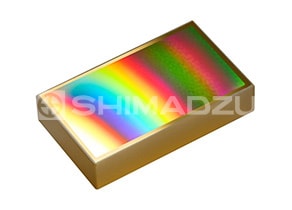Spectrometer for High-order Harmonic Generation (HHG)
What are the grating requirements for developing HHG spectrometer?
High-order harmonic generation (HHG), discovered in the late 1980s, have made remarkable progress as a new optical technology since their generation principle was clarified in 1993. Starting with its development as a coherent light source in the soft X-ray region, its application range has expanded from attosecond optical science to a wider range of fields. A team led by Professor Iwasaki[1] and Assistant Professor Motoyama[2] at the University of Tokyo is working on advanced research by a self-developed high-order harmonic generator, including spectrometer.
- [1] Center for Ultrafast Intense Laser Science, School of Science, The University of Tokyo, Professor
- [2] Quantum Chemistry Laboratory, School of Science, The University of Tokyo, Assistant Professor
- Affiliations are from the time of the interview (November 2021).
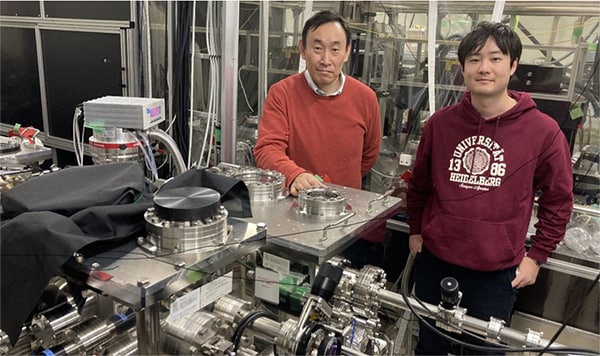
Design light pulse stronger and shorter
Structures and characteristics of many materials have previously been determined by spectroscopy. The optical technology has developed rapidly in recent years, and HHG was practiced in the late 1990s. The phenomenon occurs when a high-intensity femtosecond laser pulse is focused into a rare gas or other. The generated light has an odd number of times the photon energy of the incident laser light. For example, when a femtosecond laser pulse with a wavelength of 800 nm is used, extreme ultraviolet light with a wavelength of 32 nm is generated as the 25th-order harmonic.
"In our laboratory, we are conducting research on the interaction between light and matter. That is high-order harmonic, designed to be generating more intense and shorter pulses." says Professor Iwasaki, outlining the research.
Advantage of the high-order harmonic is that the generated pulse has temporal and spatial coherence, as well as short wavelength, short pulse. Moreover, it can be generated by small equipment at the laboratory scale, which has great advantages in ease of application. The temporal pulse width in which the condensed light of high-order harmonic exists is at the level of less than a few femtoseconds. Professor Iwasaki and his colleagues use this higher-order harmonics to create reaction fields, develop new spectroscopy, and study molecular structures.
New technology development utilizing high-order harmonics
In June 2019, Professor Motoyama and Iwasaki and his team developed a new technique for high-resolution spatiotemporal focusing measurements. By generating higher-order harmonic in soft X-ray region and focusing the light to nanometer size to irradiate the sample, the photoexcitation process that occurs in a small region of a solid sample can be measured with high temporal resolution. Although the principle had previously been known, it was difficult to fabricate a highly accurate aspheric mirror with large curvature, and the desired focusing could not be achieved.
"Therefore, we developed an original light collecting system using a high-precision ellipsoidal mirror. This system enables us to realize real-time measurement of ultrafast phenomena occurring at the nanometer scale, such as electron transfer in semiconductors and spin wave propagation in magnetic materials." says Assistant Professor Motoyama with expectation.

Fig.1 Ellipsoidal Mirror [i].
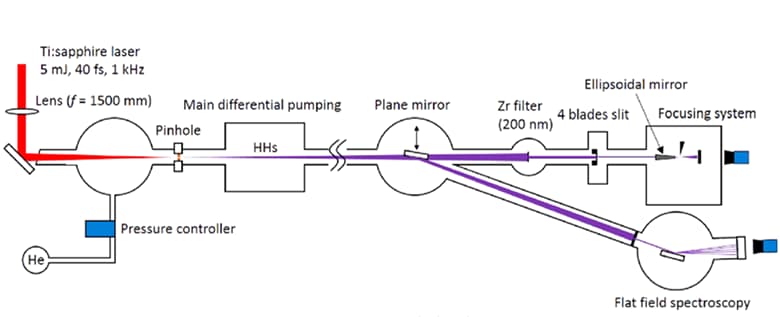
Fig.2 High-Order Harmonic Generator [ii].
Furthermore, in May 2020, their team succeeded in the microfabrication of thin films using high-order harmonic. High-order harmonic in the extreme ultraviolet region have attracted early attention as a light source for microfabrication. However, in the extreme ultraviolet region, there were no transmissive refractive optical elements such as focusing lenses.
Therefore, the team developed their own light collecting system using a high-precision ellipsoidal mirror. By using this system, high-order harmonic could be focused to the diffraction limit and irradiated on the sample. As a result, they team succeeded in micromachining on a sub-micro scale.
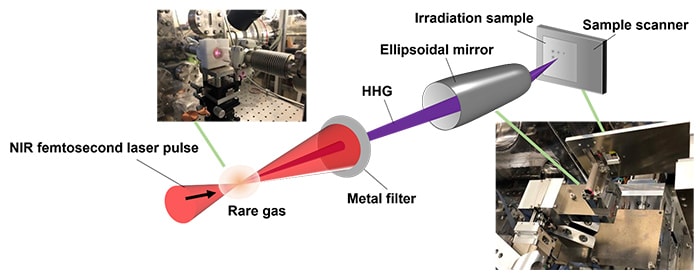
Fig.3 High-order harmonic generation in the extreme ultraviolet region and sub-micrometer focusing by a ellipsoidal mirror [iii].
Building their own equipment in order to optimize for research purposes
In their laboratory, they develop optical techniques and equipment uniquely for ultrafast phenomena analysis and microfabrication. While the high-order harmonic generator consists of various parts, Professor Iwasaki's team even build a spectrometer on their own.
Professor Iwasaki explains the reason: "When we build equipment for research, commercial products often do not fit our intended application. For example, when we build spectroscopy equipment that incorporates a microscope, we can't use commercially available spectrometers. That's why we design and build our own spectrometer. Building our own spectrometer itself is not so difficult.
Professor Iwasaki's high-order harmonic generator is compact enough to be used in a laboratory. Therefore, commercially available spectrometers with relatively large sizes may not fit well. Professor Iwasaki and his colleagues always develop the best equipment or improve their existing equipment, depending on the purpose of the research.
Key part for building original spectrometer is "Diffraction Gratings".
Requirements for "Diffraction Gratings" in spectrometers
As dispersion elements in spectrometers, prisms and diffraction gratings are used. While each element has its advantages and disadvantages, the use of diffraction gratings has increased in recent years. The reason is the good dispersion characteristics of diffraction gratings. Furthermore, Assistant Professor Motoyama explains, "Element size is also important factor when we build our own spectrometers."
“The size of gratings is important, and neither too small nor too large is appropriate. Since light is input on gratings surface at oblique incidence, we carefully check external dimensions, wavelength range and diffraction efficiency. We narrow down gratings that most closely match our requirements, by various calculations with reference to provided data such as diffraction efficiency. Then, we finally chose SHIMADZU Laminar-type Replica Diffraction Gratings for Soft X-ray Region.” says Assistant Professor Motoyama.
Laminar-type gratings have rectangular grooves and generally have the following three advantages:
1. High reflectivity in the soft X-ray region.
2. Peak wavelength of diffraction efficiency can be controlled by groove depth.
3. Unnecessary even-order diffracted light can be suppressed.
In addition, Assistant Professor Motoyama rates the user-friendliness of Shimadzu Laminar-type Replica Diffraction Gratings: "First, various sizes are lined up to match the spread angles of high-order harmonic. Second, Shimadzu can suggest the best mounting information when we want to fine-tune the wavelength range. Third, we can estimate the detection efficiency and the time required for the experiment from the diffraction efficiency data provided by Shimadzu." and so on. Shimadzu Laminar-type Replica Gratings feature low stray light by holographic exposure method and high resolution by aberration correction function.
Professor Iwasaki concludes, "Shimadzu's gratings cover the entire wavelength range of our research. We also appreciate the ease of availability because we are sure to obtain gratings with high precision. Thanks to the stable supply of important key parts, we can continue our research with confidence. I guess these are possible because Shimadzu has a lot of delivery records. Of course, with a limited research budget, I am thankful for the low price of Shimadzu gratings. I think this is an advantage unique to replica gratings."
Click here for more about Laminar-type Replica Diffraction Gratings.
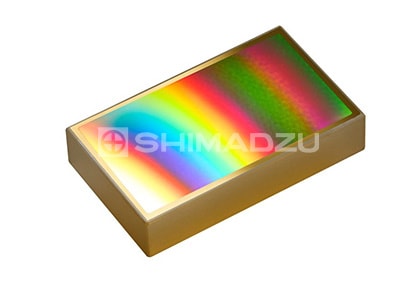
Fig.4 Laminar-type Replica Diffraction Gratings.
- i: Hiroto Motoyama et al., "Focusing system for high-order harmonics with ellipsoidal mirror" JSPE Spring Meeting 961-962(2017).
- ii: H. Motoyama, A. Iwasaki, Y. Takei, T. Kume, S. Egawa, T. Sato, K. Yamanouchi, and H. Mimura, "Broadband nano-focusing of high-order harmonics in soft X-ray region with ellipsoidal mirror" Appl. Phys. Lett. 114, 241102 (2019).
- iii: English translation of the figure in the following article:
Press Releases in 2020 - School of Science, the University of Tokyo
https://www.s.u-tokyo.ac.jp/ja/press/2020/6853/



